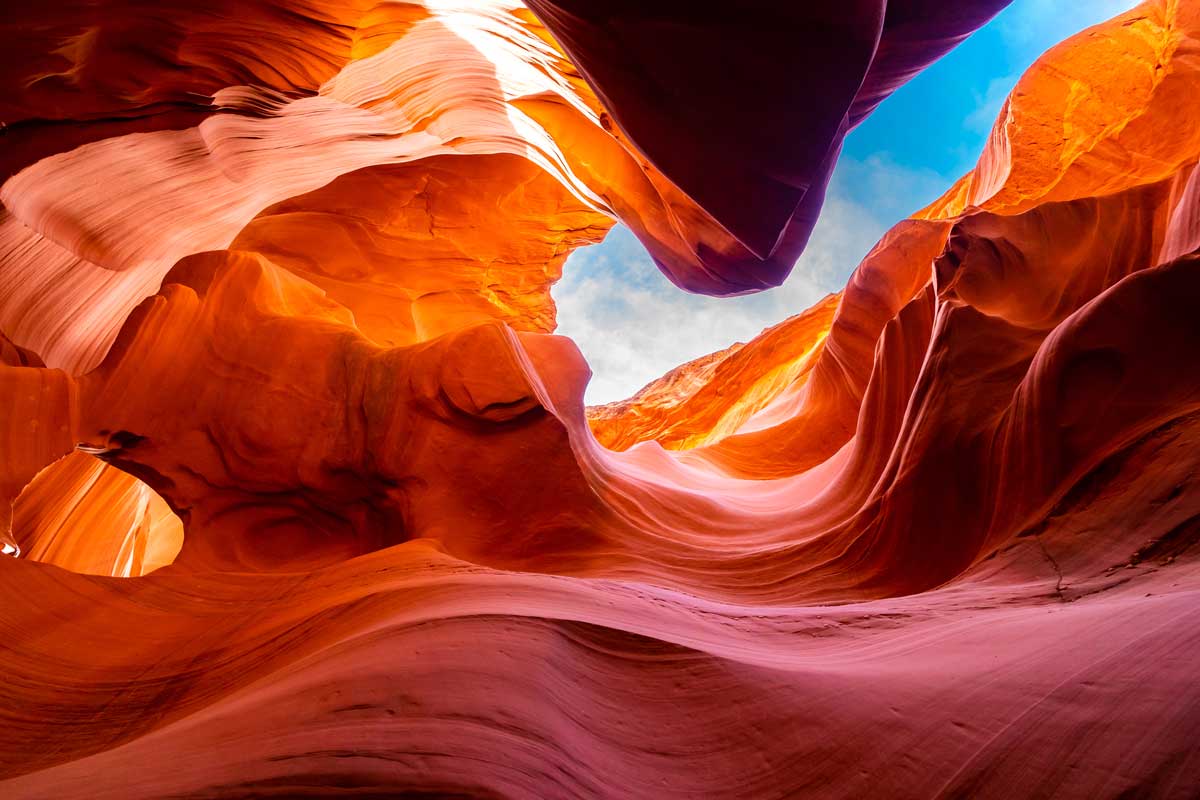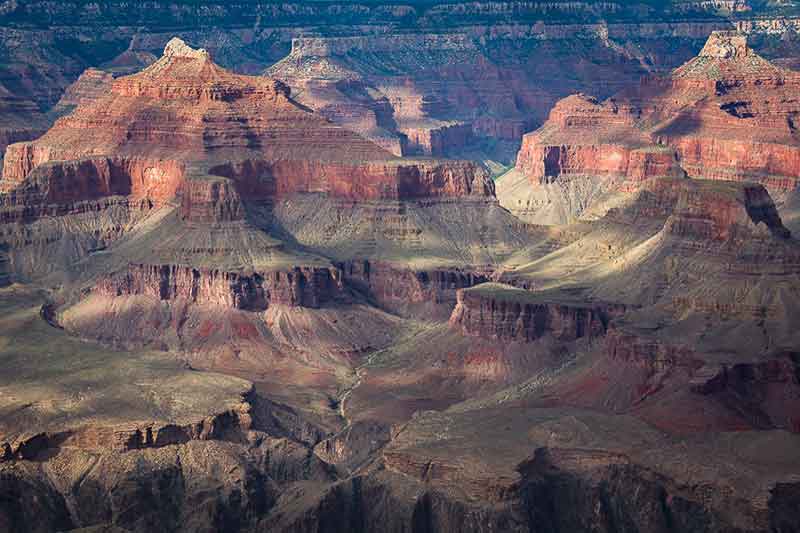You’ve heard all about the exquisite and surreal experience of Antelope Canyon, seen the beautiful, breathtaking photos, and read all the tour reviews. Now you’re ready and want to experience this expedition with your own eyes but are unsure where to start. If you’ve looked into visiting the particular Navajo sandstone canyon, you likely know that Antelope Canyon is split into two different locations, the upper and the lower. Now you’re probably asking yourself, should you visit the Upper or the Lower Antelope Canyon? Both of these canyons are a photographer’s delight, and both locations are curated by the local Navajo tribe. Even with all their similarities, a few key components of each canyon differentiate the two.
Upper Antelope Canyon
Upper Antelope Canyon, or Tsé bighánílíní dóó Hazdistazí in Navajo tongue, is known as ‘the place where water runs through rocks’. This slot canyon is well-known in Arizona. It was formed by massive flash floods that eroded the Navajo sandstone. Tourists alike can be thankful for Arizona’s monsoon seasons, as Antelope Canyon would not exist without this natural occurrence. At least, we wouldn’t have the surreal, enchanting sandstone as it appears today. Some would say it’s as if you are walking through a painted world made of sand and rock. The canyon’s popularity is a testament to its pure beauty.
The entrance and entire length of Upper Antelope is at ground level, providing easy access and tours for people of all physical abilities. The canyon begins wide at the bottom while narrowing at the top – similar to the shape of the letter A. This grants all canyon goers an easy walk through the canyon. Also, it is welcoming to anyone who may be a little concerned with tight and twisty turns. However, the narrow top causes this canyon to be slightly dimmer than its counterpart.
One of the biggest attractions of the Upper Antelope is its world-famous light beams (pictured at the top of the article). This is what makes it really stand out in comparison to the Lower Antelope. Peeping through the top, these alluring shafts of pure sunlight are a staple to Antelope Canyon. Those unfamiliar with this slot canyon may recognize the surreal, dreamlike imagery. Any tourist researching this subject will learn these light beams occur more commonly in the upper canyon than the lower.
Photographer Peter Lik captured these enchanting light beams in his photograph, “Phantom“. It has become one of the world’s most famous and expensive photographs, selling for a whopping $6.5 million. If you’re interested in snapping a multi-million dollar shot to break the bank yourself, catching these light beams highly depends on the time of day you book your tour. Naturally, every photographer is looking to capture their own Moby Dick of snapshots when booking their tour, just as likely as anyone else who does a little research and comes across an article such as this.
What does that mean for you exactly? The peak times to visit Upper Antelope are going to be booked in advance. They are going to be busy, and they are going to be packed. While Upper Antelope’s base is wider than the lower canyon’s, it can still feel more crowded. This is due to the number of people chasing their $6.6 record-breaking-million-dollar photo. Upper Antelope itself is about 300 feet long, with up to 100 people in it at a time. Upper Antelope Canyon tours typically will last about 45 minutes to an hour. It depends on how busy the tourism traffic is during your visit. Being the more popular option of the two, Upper Antelope Canyon can be a little pricier than Lower as well. Is the extra expense, crowds, and light beams worth it over Lower Antelope? Let’s find out!
Lower Antelope Canyon
Now, onto the baby brother, Lower Antelope Canyon. Hazdistazí, or ‘spiral rock arches’ by the Navajo, is located several miles from big brother Upper. The origin of its name comes from the twisty and curvy pathways you will find within the canyon. The entrance into Lower Antelope is a little different from the upper canyon. A flight of steep, sturdy, and safe metal steps leads you down into the canyon. Before this staircase was installed, visitors would have to climb ladders in certain canyon areas – fun fact!
However, even with the handrails and stability of the staircase, it can be a little more difficult than Upper Antelope. The entrance stairs may cause some minor mobility issues for a certain demographic of guests wishing to visit Antelope Canyon. Not to worry, though; the Navajo guides are quite patient and allow for everyone to trek down them at their own pace.
Once you have ventured down into the canyon, anyone inside Upper Antelope Canyon might notice that the shape of Lower Antelope is a topsy-turvy alternate. This canyon has a more narrow walking space on the ground of the canyon with a wider top – similar to the shape of the letter V. The stairs and twisty path of the Lower Antelope make this canyon a little more fun for families or adventurous individuals heading up to Page, AZ. If you’re a fan of the word or activity ‘spelunking’, you’ll love diving into Lower Antelope Canyon.
Unlike the upper canyon, you will not find many mystical light beams shooting down from the skies above. This should not deter you from Lower Antelope, however, as the top opening of the canyon still allows light to enter your pathways. So much so that the light reflects and glows off the walls in a similar fashion as the light beams, just not as much… “beamy”. Photo opportunities are still very prevalent in the lower canyon. However, reports of any multi-million dollar photos captured here have yet to be determined. Some photographers prefer Lower Antelope, as the canyon’s shape allows for a more bright and warm experience, adding more “personality” to their photos.
Most guests find Lower Antelope can be less crowded during peak hours. This is excellent for anyone looking for a more intimate experience. The lower canyon is bigger in size, translating into a lengthier tour – taking about an hour to an hour and a half to trek through the canyon. Another nice benefit to the lower canyon is that you will enter by climbing down into one end and re-emerging on the opposite side. This makes the lower canyon seem a lot less crowded, as everyone is going in one direction to the end. No dodging tourists coming from the opposite direction here! To top everything off, Lower Antelope is a little less expensive. We don’t know about you, but we do love ourselves a good deal.
How to get the Best Experience from Antelope Canyon
As we come to our conclusion on the differences, it’s safe to say that Antelope Canyon is pretty great! Whichever canyon you choose, you’d be hard-pressed to feel like you made the wrong decision. Based on the information above, you should be able to determine which one caters to your liking.
Regardless of which one you choose, one final question remains… When should I choose to visit the Upper or Lower Antelope? Time is an all-important factor when choosing to visit Antelope. As mentioned earlier, lighting and the trajectory of the sun’s rays will greatly impact how intense the walls will glow in Lower Antelope. It will also determine how prevalent the light beams will be inside Upper.
If you’re trying to catch the best lighting, our suggested times to visit are between the end of March through October. If you’re trying to catch Antelope Canyon at a slower, less busy time, you should plan on traveling to the canyons between November and the beginning of March. Specifically, when booking your tour time, Upper’s magic hour is the 10:30 am tour slot.
Lower is a little more flexible, as the canyon’s top is wider, allowing the sun to have a wider range to soak the canyon in light. When visiting Lower Antelope, we suggest anywhere between 10 am -1 pm. If those times don’t quite fit into your schedule, do not fret! Antelope Canyon is still that beautiful, awe-inspiring, and surreal enchanting vortex of water-washed sandstone 24 hours a day. However, we do not recommend going in the dead of night, as it’s probably quite dark down there.
Similar to Monument Valley, Antelope Canyon is a part of the Navajo Indian Reservation. Naturally, these guides have a passion for preserving Antelope Canyon while sharing a window into their world and culture with us. Being frequent spelunkers of both Upper and Lower Antelope Canyon, these guides know some of the best picture-taking techniques! So don’t be afraid to ask your guide for some tips and tricks on photography in either canyon!
While you’re in the area, the Cameron Trading Post is a great addition to your travel itinerary if you ever trek over to Page. The trading post was established in the early 1900s near the Little Colorado River and stays in the vein of the Navajo Nation. This is an excellent stop for those who would like to discover a deeper meaning in the culture of the land. Horseshoe Bend is located near Antelope Canyon, making up one of the most popular duos on social media today. This 980-foot-deep scenic overlook is located just 20 minutes away from Antelope Canyon, making them practically neighbors! Anyone setting out to see nature’s beauty at work in Page, Arizona, should always include a stop at our favorite horseshoe-shaped bend.
Upper or Lower?
Here is a breakdown of the pros and cons of each tour for you.
Upper Antelope Canyon Perks:
- High chance of seeing the enchanting light beams
- Geared towards the avid photographer
- An absolutely stunning, surreal, and enchanting atmosphere
- No mobility drawbacks
Drawbacks:
- A single entrance causes guests to turn around and walk back to the beginning once they’ve reached the canyon’s end
- More popular, more crowds
- Pricier tour of the two canyons
- Considered more “touristy”
Lower Antelope Perks:
- Lengthier tour
- More intimate experience
- Shorter wait time
- More affordable
- Entry one way into the canyon, exit out the other end
- Less crowded than the other canyon
Drawbacks:
- Entrance to the canyon is only accessible via a steep stairway
- Not recommended for anyone with mobility issues
- Just as stunning, surreal, but without the prevalence of light beams
- Less name recognition compared to Upper Antelope
Here is what we take away from all of this: Lower Antelope might be the better choice if you’re not a professional photographer. It’s not as crowded, provides great photo opportunities, and is a little cheaper to boot. The peak tour times also give you a little more flexibility. Ultimately, there are no wrong choices. Both canyons are full of such wonder and awe that leaves most newcomers speechless. After this intensive guide, we hope you feel confident when planning your trip to Antelope Canyon!
For those wishing to visit Page but don’t want to do all the driving, DETOURS American West operates both public and private Lower Antelope Canyon tours from Phoenix & Scottsdale, as well as Antelope Canyon Tours from Flagstaff. If a fully guided and hassle-free experience is more your speed, give the DETOURS team a call today!



